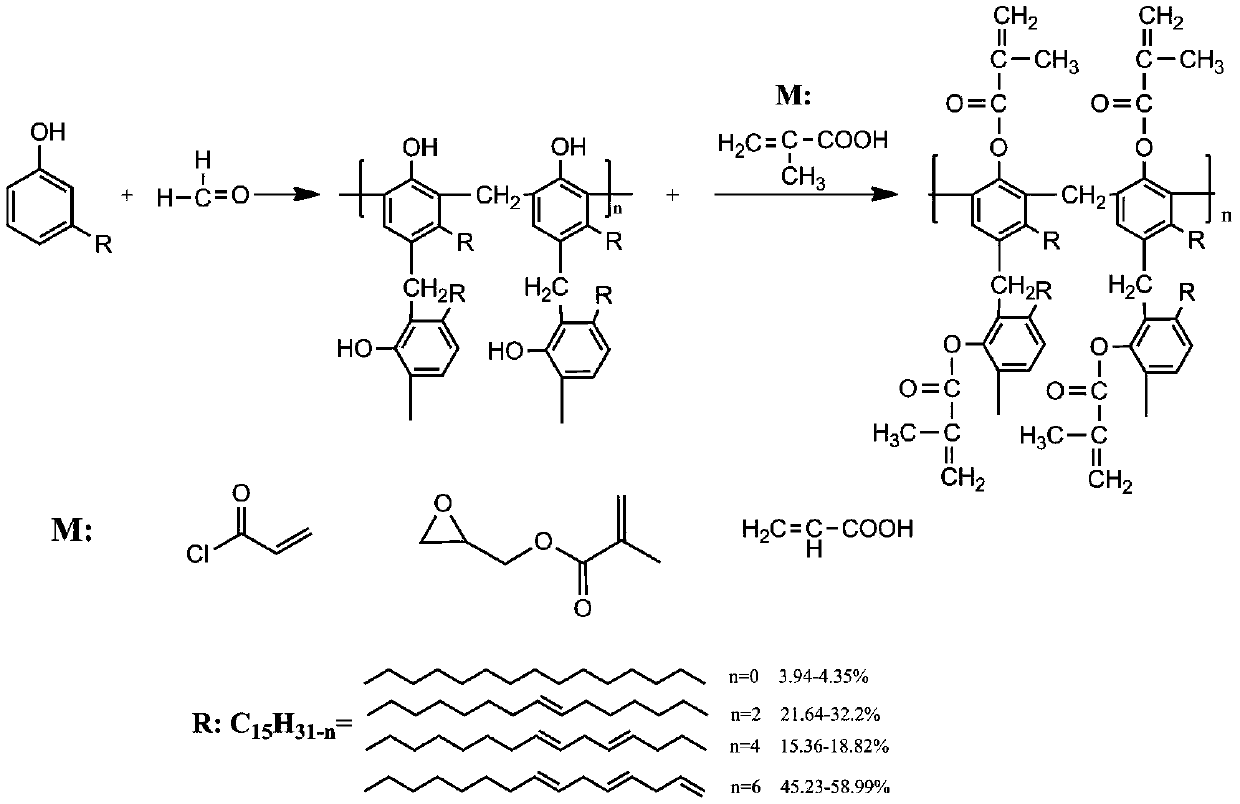Cardanol-based photosensitive resin for 3D printing and preparation method thereof
A cardanol-based, 3D printing technology, applied in the direction of additive processing, etc., to achieve the effect of increased and controllable crosslinking rate, improved impact strength, and reduced application cost
- Summary
- Abstract
- Description
- Claims
- Application Information
AI Technical Summary
Problems solved by technology
Method used
Image
Examples
Embodiment 1
[0025] A kind of preparation method of cardanol-based photosensitive resin for 3D printing, it comprises the steps:
[0026] 1) Using xylene as solvent, add 100g of cashew nut shell liquid (CNSL), 4g of hexamethylenetetramine (H powder), and then add a certain amount of distilled water to make the mixed system react at 80-90°C for 1-3 hours, and then heat up to 130-140°C for reflux treatment for 1-2 hours to obtain cardanol-formaldehyde polycondensate (PCF);
[0027] 2) Use 0.8g p-toluenesulfonic acid as a catalyst, 1g 1,4-hydroquinone as a polymerization inhibitor, and 30g xylene as a solvent. After mixing, add 50g cardanol formaldehyde condensation polymer (PCF) and 50g acryloyl chloride (AC), then reflux at 80-90°C for 6 hours, then heat up to 100-110°C, and react again for 5-6 hours to obtain acryloyl chloride cardanol phenolic photosensitive resin (MPCF), that is, cardanol-based photocuring Prepolymer; Wherein, the viscosity of acryloyl chloride cardanol phenolic photose...
Embodiment 2
[0032] 1) Using xylene as solvent, add 100g of cashew nut shell liquid (CNSL), 4g of hexamethylenetetramine (H powder), and then add a certain amount of distilled water; make the mixed system react at 80-90°C for 1-3 hours, and then heat up to 130-140°C for reflux treatment for 1-2 hours to obtain cardanol-formaldehyde polycondensate (PCF);
[0033] 2) With 0.8g p-toluenesulfonic acid as catalyst, 1g 1,4-hydroquinone as polymerization inhibitor, and 30g xylene as solvent, after mixing, add 34g cardanol formaldehyde condensation polymer (PCF) and 66g methyl Acrylic acid (MAA), reflux at a temperature of 80-90°C for 6 hours, then raise the temperature to 100-110°C, and react for 5-6 hours to obtain a methacrylic cardanol phenolic photosensitive resin with a viscosity of 1352mPa·s;
[0034]3) after the solvent rotary evaporation in the methacrylic acid cardan phenolic photosensitive resin that step (2) makes, 50g methacrylic acid cardan phenolic photosensitive resin is added to 2...
Embodiment 3
[0038] 1) Using xylene as a solvent, add 100g of cashew nut shell liquid (CNSL), 4g of hexamethylenetetramine (H powder), and then add a certain amount of distilled water to make the mixed system react at 80-90°C for 1-3 hours , and then heat up to 130-140° C. for reflux treatment for 1-2 hours to obtain cardanol-formaldehyde polycondensate (PCF);
[0039] 2) take 0.8g p-toluenesulfonic acid as catalyst, 1g 1,4-hydroquinone as polymerization inhibitor, 30g xylene as solvent, after mixing, add 50g cardanol formaldehyde condensation polymer (PCF) and 50g acrylic acid ( AA), reflux at 80-90°C for 6 hours, then heat up to 100-110°C, and react for 5-6 hours to obtain an acrylic cashew phenolic photosensitive resin with a viscosity of 1710mPa·s;
[0040] 3) After the solvent in the acrylic cardanol phenolic photosensitive resin prepared by step (2) is rotated and evaporated, 50g of acrylic cardanol phenolic photosensitive resin is added to the 2,4,6-trimethylmethanol that is a photo...
PUM
| Property | Measurement | Unit |
|---|---|---|
| Viscosity | aaaaa | aaaaa |
| Impact resistance | aaaaa | aaaaa |
| Impact resistance | aaaaa | aaaaa |
Abstract
Description
Claims
Application Information
 Login to View More
Login to View More - R&D
- Intellectual Property
- Life Sciences
- Materials
- Tech Scout
- Unparalleled Data Quality
- Higher Quality Content
- 60% Fewer Hallucinations
Browse by: Latest US Patents, China's latest patents, Technical Efficacy Thesaurus, Application Domain, Technology Topic, Popular Technical Reports.
© 2025 PatSnap. All rights reserved.Legal|Privacy policy|Modern Slavery Act Transparency Statement|Sitemap|About US| Contact US: help@patsnap.com

